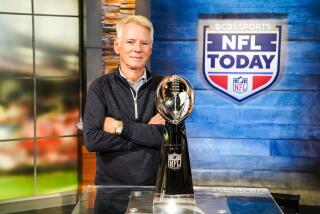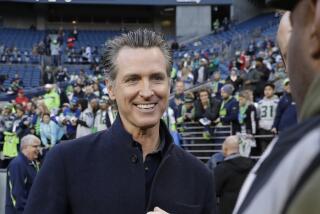Has Safety Taken a Hit on Pro Teams?
- Share via
In recognition of Men’s Health Month, sports agent Leigh Steinberg of Newport Beach talks with Times staff writer Martin Miller about safety in the increasingly dangerous world of professional athletics. Steinberg represents more than 100 athletes, including National Football League stars Steve Young and Drew Bledsoe and newcomer Ryan Leaf.
*
Question: Are professional sports more or less dangerous today than they were 10 years ago?
Answer: I think there’s no question they are more dangerous. It’s a simple matter of physics. Larger bodies are moving at more rapid rates of speed. In football, that means collisions that produce explosive crashes. Even in basketball, there’s just a tremendous amount of contact under the boards these days, which is really disguised from the home viewer.
*
Q: Why are today’s athletes bigger than those from one or two decades ago?
A: Diet and training techniques have vastly improved. And athletes are training all year round, which they rarely used to do. It’s translated into more strength and speed than anyone’s ever seen.
*
Q: What’s the most serious safety issue in sports today?
A: A major issue is concussions. [Two of Steinberg’s star quarterback clients, Troy Aikman of the Dallas Cowboys and Steve Young of the San Francisco 49ers, have suffered repeated concussions.] In public, we treat a concussion as an exciting, fun event: “Someone got their bell rung.” We see the marketing of videotapes of great hits [in football]. Well, someone is on the receiving end of that hit. When the logo of the NFL has two helmets colliding, which almost certainly would result in a concussion, we definitely have a problem glorifying concussions.
*
Q: Why isn’t the public more concerned about concussions?
A: Much less is known about brain functions than is known, say, about knee or hip injuries. There’s no way to know how many hits are too many and which kind of hits will trigger dangerous symptoms.
Several years ago in Newport Beach, we assembled a group of doctors who specialize in head trauma and brain function, and they pointed out that the cumulative effects of multiple concussions can be as serious as Alzheimer’s disease, Parkinson’s disease and premature senility. It can entail the loss of memory and identity. It’s one thing to know a player in his later years is going to lean over and pick up his kids and have a few aches and pains, but it’s another for them to not recognize those kids.
*
Q: How do athletes view the situation?
A: I believe they are in a strong state of denial about it. The players are taught that “real” men live with pain, they play with pain. In a normal value system, long-term health is the No. 1 priority. But in the NFL, the game and the play are the most important things.
Also, the protective equipment is illusory. The players think that they have complete protection and then throw their bodies around with reckless abandon. The equipment really provides little protection. It’s an illusion.
*
Q: What can be done about it?
A: A lot of this is very preventable. In sports, we need some type of diagnostic regimen that is standardized. There should be a list of symptoms, judged consistently from sport to sport and team to team, accompanied by a grading system. It should say something like a 0.9 concussion means you sit out until medically cleared. A 0.6 means you sit out a week. A 0.4 means sit out the game and so on.
*
Q: What else?
A: The other key is if we can send a man to the moon or send a spacecraft to Mars, we ought to be able to provide athletes with better helmets. There has to be more emphasis on concussion-resistant helmets.
Also, when it comes to rules in football, you shouldn’t lead with your head in blocking and tackling, nor should the player be hit in a gratuitous way when play is over.
This particularly applies to the quarterback, who, once he has released the ball and is not trying to escape, shouldn’t be hit period. [Such hits] don’t add much to the game, since people in the stands and home viewers are watching the wide receivers and cornerbacks.
*
Q: When you’ve suggested such rule modifications, what happens?
A: Anyone who attempts to address the situation is accused of messing with the sanctity of the game. “Do we want to put dresses on athletes? Do we want to put them in rocking chairs?” That’s been very difficult to beat. And for many players, the abstraction of long-term health is just that, a long-term abstraction.
It’s not a popular message. The counter-argument is the players have accepted the risk, they understand what’s going on, and they’ve willingly chosen to play anyway.
*
Q: What has to happen before things will change?
A: I think it will take something very traumatic, like someone dying, before it’s dealt with. The last time I made this series of suggestions, a doctor in the NFL said that was all fluff. So I said thank you on behalf of a generation of athletes [who won’t have the protections they should].
*
Q: What other unnecessary risks do players face?
A: Artificial turf. A conference is being planned for early next year to examine the alternatives. The question is, is this the safest playing surface? There are turfs that feel like concrete. There are turfs that give to the point where a player can get hurt without contact because his foot sticks.
*
Q: Artificial turf is often the subject of complaints from players and even fans. Why does it hang on?
A: Part of the rationale is aesthetics. It looks better than natural grass and is much easier to maintain. And, of course, it’s cheaper.
*
Q: What prompted you to call for these changes?
A: It was the NFC championship game between the Dallas Cowboys and San Francisco 49ers four years ago. Troy Aikman suffered a concussion sometime after the first half. Dallas ended up winning.
I went to visit Troy that night at Baylor Medical Center in downtown Dallas. The city was awash in celebration. Horns honking, people screaming. Everything. And there was Troy sitting in a darkened hospital room with very little concept of where he was.
He asked me, “Where am I? Why am I here? How did I play? Are we going to the Super Bowl?” When I answered him, his face would brighten. Then, about five minutes later, he would ask the same questions again.
It scared me. I began to feel that if I was going to represent athletes, it wasn’t enough to make sure they had enough money in their bankbooks when the most fundamental issue is their health.
More to Read
Go beyond the scoreboard
Get the latest on L.A.'s teams in the daily Sports Report newsletter.
You may occasionally receive promotional content from the Los Angeles Times.










